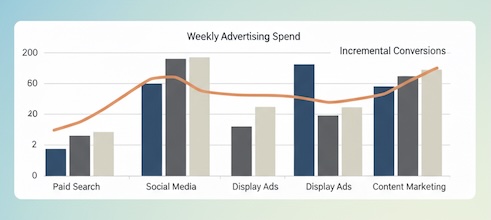Why “less data” doesn’t mean “less insight”
Privacy rules, browser changes, and platform policies trimmed our ability to trace individuals. But most strategic questions don’t require identity; they require signal quality. Instead of chasing perfect user trails, reframe decisions around:
- Cohorts, not people: groups defined by context (campaign, geo, device, intent).
- Outcomes, not exhaust: conversions, retention, revenue per visit/user.
- Causality, not curiosity: structured comparisons and controlled changes.
This mindset removes the false trade-off between compliance and clarity.
Principles of privacy-first measurement
- Minimize by design
Collect only what’s needed to answer a clearly stated question. If the question is “Does creative A outperform B on mobile?”, device class and campaign tag matter; names and emails don’t. - Aggregate early
Prefer counts, rates, and distributions over raw event streams tied to individuals. Aggregation reduces risk and keeps analysis focused on decisions. - Keep context, drop identity
Contextual dimensions (channel, content category, device, time window) often explain more variance than user identifiers—and they’re safer. - Be transparent
Document what is (and isn’t) measured, consent states, and the statistical uncertainty that results. Trust grows when limits are explicit.

High-signal, low-risk data you can rely on
- Event counts and key outcomes: visits, add-to-cart, trial starts, upgrades, cancellations, refunds. These power rate-based metrics (conversion, activation, churn) without PII.
- Content and feature context: template, category, feature flag, price tier—great for understanding where value happens.
- Time windows: session/day/week buckets reveal seasonality and recency patterns while avoiding user stitching.
- Campaign and channel tags: when standardized, these are enough to compare efficiency across website traffic sources and budgets.
- On-device signals (where allowed): rough performance metrics (e.g., page weight buckets) to relate experience quality to outcomes without fingerprinting.
Models that work without identities
You don’t need cross-site IDs to answer “what works?” These privacy-compatible approaches are robust:
- Cohort comparisons
Group visitors by first touch (channel/campaign), geo, or content theme. Track outcome rates by cohort over fixed windows (e.g., 0–7 days, 8–30 days). This answers questions like “Do readers from comparison guides convert better than from listicles?” without individual trails. - Geo and time-based experiments
Rotate creatives or offers by region or week. Differences in outcomes across matched regions/time slices provide lift estimates while keeping data aggregated.

- Lightweight MMM (media mix modeling)
Regress weekly conversions on spend by channel, controlling for seasonality and promotions. MMM is channel-level by nature—no user IDs required. - Path shape, not person path
Analyze state transitions (e.g., Landing → Category → Product → Cart) as rates, loop frequency, and time-to-next-state. You’ll spot bottlenecks without tracking singular users across devices. - Propensity buckets
Use privacy-safe features (e.g., content category + device + recency) to score sessions into high/medium/low intent buckets. Then observe how each bucket responds to changes—no identity, just context.
KPIs that thrive in a privacy-first world
Focus on metrics that are both decision-useful and compliant:
- Visit-to-value rate: % of visits that reach a meaningful milestone (add-to-cart, pricing view, key feature used).
- First-week activation: % of new trials reaching “aha” within 7 days. Works with cohorting, not user tracking across months.
- Incremental lift: difference in outcome rates between exposed vs. control regions/weeks.
- Content assist rate: share of conversions preceded (within the same session or day) by specific content categories or tools (e.g., comparison, calculator).
- Experience-to-outcome link: conversion deltas across performance buckets (e.g., Core Web Vitals or page weight bands).
These KPIs tie directly to product, content, and media decisions without requiring personal identifiers.

Filling the gaps when consent is limited
Consent-aware measurement means some traffic is unobservable at a granular level. You can still estimate impact with disciplined inference:
- Calibration windows
When consent levels are temporarily higher (e.g., during a sale), measure relationships (e.g., source → conversion). Use those coefficients to inform periods with lower visibility, with caution bands. - Triangulation
Cross-check outcomes from multiple sources: platform-reported conversions, aggregated site outcomes, and finance bookings. If two move and one doesn’t, investigate definitions and attribution windows. - Sensitivity analysis
Report ranges, not point myths. “Channel X drives 22–28% of incremental sign-ups under reasonable assumptions.” Ranges are honest—and still actionable. - Lag-aware reporting
Use fixed attribution windows (e.g., 7/28 days) and delay final calls until windows close. Publish provisional vs. finalized numbers to set expectations.
Turning privacy into a strategic advantage
- Cleaner questions → cleaner data
Privacy constraints force sharper hypotheses. Teams that write the question first (“Which three content types most efficiently start high-intent sessions?”) outperform those hoarding data “just in case.” - Fewer vanity dashboards
Without user-level glitter, organizations default to metrics executives actually understand: cost per incremental outcome, activation rate, revenue per visit—stronger stories, better decisions. - Trust as a growth lever
Clear consent UX, conservative data handling, and transparent analytics practices become part of your brand. Users who feel respected are more likely to opt in over time, increasing signal quality.
Communicating uncertainty like a pro
Management doesn’t need every datapoint; they need confidence to act. Frame findings with:
- Decision, not data: “Ship the ‘Fit-Finder’ on all product pages” (decision) → “because it reduces loop rate Product↔Size Guide by 31% in mobile cohorts, yielding +0.6 pp add-to-cart” (evidence).
- Magnitude + risk: Present a central estimate plus a conservative bound. “Expected +8–12% trial starts; worst-case +4%.”
- Assumption ledger: One slide that lists key assumptions, data exclusions (e.g., non-consented traffic), and how those affect directionality.
This builds credibility without exposing identities or overpromising precision.
Red flags (avoid these)
- Identity workarounds in disguise (fingerprinting via entropy signals). High legal and reputational risk, minimal extra insight.
- Endless stitching projects with low consent rates. Costly, brittle, and often unnecessary for core decisions.
- Single-source truth claims when sources have different windows/definitions. Always reconcile or show both with context.
- KPIs that can’t change decisions (e.g., pageviews for their own sake). If no action follows a metric move, drop it.
A practical, privacy-first checklist
- Start with the business question and the minimum context to answer it.
- Use cohorts, not identities; report rates and differences, not trails.
- Prefer experiments (time/geo) and MMM for channel impact.
- Link experience quality bands to outcomes, not users.
- Publish ranges with an assumption ledger; close the loop when windows finalize.
- Document consent logic and exclusions on every dashboard.

Bottom line
Privacy-first analytics isn’t analytics with handcuffs. It’s a better habit: collect less, reason more, and design comparisons that reveal cause over coincidence. When you trade identity for clarity—cohorts, experiments, and context—you keep insight, earn trust, and make faster, safer decisions.

